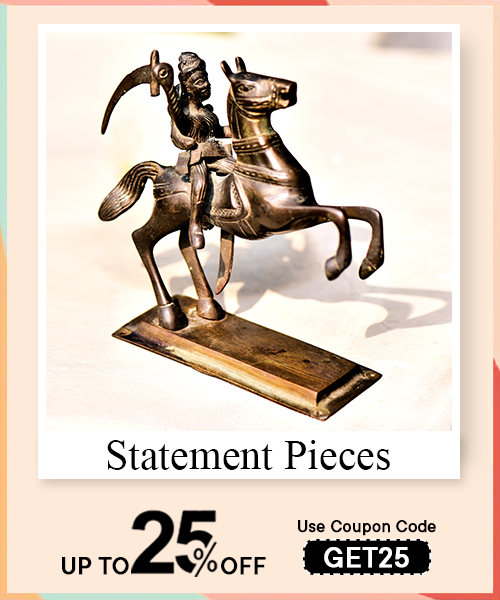Gond painting is a traditional art form of the Gond tribal community from central India. It is known for its intricate patterns, vibrant colors, and depiction of nature, animals, and daily life. This artwork often represents folklore and religious beliefs, telling stories through detailed designs. Gond artists use natural colors and unique techniques that make each piece stand out.
Gond art originated from the Gond tribal communities in Madhya Pradesh, India. This traditional art form has roots in tribal customs and rituals, reflecting the Gonds' deep connection with nature and mythology. Over time, it spread to other regions, gaining recognition as a distinctive cultural art form.
Traditional Gond artwork uses natural materials. Artists create colors from plants, soil, charcoal, and even cow dung. Brushes are often handmade, using sticks or bamboo. Today, some artists use modern materials like acrylics and canvas, but they still maintain the traditional essence of Gond art.
Gond art often portrays nature, animals, folklore, and daily life. Common themes include:
- Trees
- Birds
- Fish
- Mythical creatures
These subjects symbolize harmony, growth, and cultural heritage, showcasing the Gond community's strong connection with the environment.
Gond illustrations are characterized by intricate patterns, vibrant colors, and detailed designs. Artists use dots, lines, and curves to fill their creations, adding texture and depth. These unique patterns make each artwork visually striking and culturally significant.
Gond art stands out for its storytelling and use of vibrant patterns. Unlike other traditional forms, it relies heavily on geometric shapes, repetitive motifs, and earthy themes. Its distinct style captures the essence of tribal life, making it unique among Indian art traditions.
Read More : Exploring Radha Krishna Paintings: History, Techniques, and Symbolism
Gond artists traditionally use natural brushes made from twigs or bamboo. They also use their fingers to apply colors. Modern artists may work with synthetic brushes, canvas, and acrylic paints while retaining traditional patterns and techniques.
Animals play a significant role in Gond art, symbolizing strength, wisdom, and harmony. Artists depict them using detailed patterns and vibrant colors, making each representation unique. Popular animals include:
- Elephants
- Peacocks
- Tigers
- Deer
Each holds cultural and spiritual meaning.

The patterns in Gond art represent movement, life, and energy. Repeated motifs like dots, lines, and waves bring the artwork to life. These patterns not only enhance visual appeal but also add layers of meaning to the story being told.
Traditional Gond art uses earthy colors made from natural sources like leaves, stones, and soil. Common colors include:
Modern Gond artists often use acrylics and bright hues to make their creations more vibrant and durable.
Folklore is an integral part of Gond art. Artists depict tales of gods, mythical creatures, and tribal legends through their work. These visual stories preserve the Gonds' oral traditions and pass down cultural values to future generations.
Gond art reflects the cultural heritage of the Gond community. It represents their beliefs, traditions, and close relationship with nature. By creating this art, the Gonds preserve their identity and share their rich history with the world.
Initially, Gond art was created on walls and floors during festivals or rituals. Over time, it transitioned to paper and canvas, making it accessible to a global audience. Modern artists experiment with contemporary themes while maintaining traditional techniques.
Read More : Digital Painting: A Beginner's Guide to Tools, Techniques, and Software
Nature is central to Gond art, symbolizing life, harmony, and sustenance. Artists frequently depict trees, rivers, and animals to show their deep respect for the environment. These elements also serve as metaphors for spiritual and cultural beliefs.
Gond murals are large-scale artworks traditionally created on walls. These murals often depict scenes from folklore, celebrations, or daily life. They serve as decorative elements and hold cultural significance during festivals and community gatherings.
Prominent Gond artists include:
- Jangarh Singh Shyam
- Bhajju Shyam
- Durga Bai
Jangarh Singh Shyam brought this tribal art form to the global stage, inspiring a new generation of Gond artists who continue to innovate and preserve this tradition.
Storytelling is a core element of Gond art. Artists narrate tales from folklore, mythology, and daily life through their work. Each illustration serves as a visual story, connecting the viewer to the Gonds' rich cultural heritage.
Yes, Gond art is eco-friendly because it traditionally uses natural materials like plant-based pigments and handmade tools. This sustainable approach reflects the Gonds' deep respect for nature and their commitment to preserving the environment.
Gond sketches serve as the foundation for more elaborate artworks. They outline the basic composition, helping artists plan their intricate designs and patterns. These preliminary sketches are an essential step in creating detailed Gond illustrations.
Today, Gond art is not limited to walls or paper. It is used to create:
- Home décor items
- Textiles
- Fashion accessories
This versatility helps keep the art form relevant and introduces it to new audiences worldwide.
Gond artists face challenges like limited resources, lack of recognition, and competition from commercial art. Efforts to promote and preserve this art form, including exhibitions and workshops, are crucial for supporting these talented artists.
Gond art is often taught informally within families, where skills are passed down from one generation to the next. Workshops and schools also help preserve this tradition by teaching children the techniques and history of Gond art.
Gond portraits are detailed representations of individuals, gods, or animals. These portraits combine vibrant patterns and storytelling, capturing the essence of the subject while maintaining the unique style of Gond art.
Gond art is important globally because it highlights the creativity and cultural heritage of an indigenous community. Its intricate patterns and storytelling resonate with audiences worldwide, fostering appreciation for diversity and traditional craftsmanship.
We can support Gond artists by purchasing their work, attending exhibitions, and promoting their art on social platforms. Supporting initiatives that preserve and promote Gond art ensures that this rich cultural tradition thrives for future generations.
Gond Painting is unique because of its intricate patterns, vibrant colors, and storytelling approach. Artists use dots, lines, and geometric shapes to create visually captivating designs. The artwork often depicts themes of nature, folklore, and mythology, offering a deep connection to the Gond community's traditions. Unlike many other art forms, Gond art emphasizes harmony and movement, bringing the subjects to life through its dynamic patterns and detailed textures. This distinctive style sets Gond artwork apart, making it a cherished cultural treasure.
Traditional Gond art employs simple tools like handmade brushes crafted from bamboo or twigs. Artists often use natural dyes extracted from plants, stones, and charcoal. The technique involves layering dots, lines, and curves to create intricate designs. Modern Gond artists might use acrylic paints, synthetic brushes, and canvas while staying true to the traditional patterns. This fusion of old and new techniques keeps the art form vibrant and adaptable to contemporary contexts.
Gond art is deeply rooted in storytelling. Each piece narrates tales from mythology, tribal folklore, or everyday life. For example, a depiction of a tree might symbolize growth and community, while animals could represent strength or wisdom. The use of repetitive patterns and vibrant colors enhances the narrative, allowing the viewer to interpret the story visually. This storytelling aspect makes Gond art not just an aesthetic experience but also a medium for preserving cultural history.
Nature is a central theme in Gond art, reflecting the Gond community’s spiritual connection with the environment. Trees, animals, rivers, and mountains are often depicted as symbols of life, harmony, and resilience. For instance, the Tree of Life is a common motif representing growth and sustenance. These elements are stylized with intricate patterns, showcasing the beauty and significance of the natural world. Gond art reminds us of the importance of living in balance with nature.
Read More : Tanjore Painting: A Traditional Indian Art Form with Rich History and Cultural Significance
Gond Painting holds significant cultural value as it represents the heritage and traditions of one of India’s largest tribal communities. The art form captures the beliefs, rituals, and everyday experiences of the Gonds, making it a visual record of their rich history. Additionally, it serves as a means of storytelling, preserving folklore and myths for future generations. By appreciating Gond art, we celebrate India’s cultural diversity and the creativity of its indigenous people.















